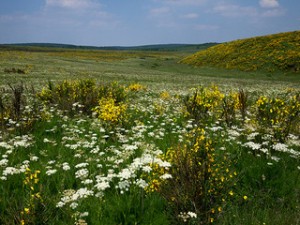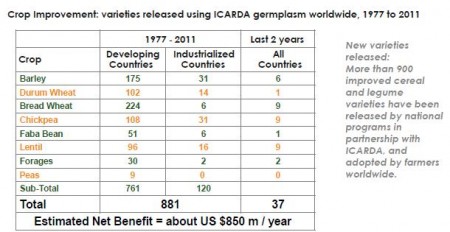- Wow, that’s one huge pumpkin!
- Genomic whiz-bangery, which was apparently not involved in producing the above pumpkin, continues to hold much promise for wheat yields. And your jetpack is in the mail. I would ban the use of the word promise in this type of article. But since I can’t do that, I promise not to link to them ever again.
- Jess gets to grips with Timorese nutrition. Get those local landraces back from any genebank that has them, Jess. And don’t forget to collect any remaining ones.
- Then you could do some cool Seeds-for-Needs-type stuff.
- And maybe some local breeding too?
- And don’t forget local fruit trees!
- Because you know investing in nutrition is really cost-effective.
- Though of course it’s not just about the money.
- Especially when it comes to coffee.
- Or cacao for that matter.
- They shoot hogs, don’t they? Maybe even in East Timor. Goats, alas, have problems of their own.
- And as for dogs, we forced them to digest starch. What even the dingo? I bet there are dingo-like dogs in East Timor.
Brainfood: Climate in Cameroon, Payments for Conservation, Finger Millet, GWAS, Populus genome, miRNA, C4, Cadastres, Orange maize, Raised beds, Contingent valuation, Wild edibles, Sorghum genomics, Brazilian PGR, Citrus genomics
- Climate and Food Production: Understanding Vulnerability from Past Trends in Africa’s Sudan-Sahel. Investment in smallholder farmers can reduce vulnerability, it says here.
- An evaluation of the effectiveness of a direct payment for biodiversity conservation: The Bird Nest Protection Program in the Northern Plains of Cambodia. It works, if you get it right; now can we see some more for agricultural biodiversity?
- Finger millet: the contribution of vernacular names towards its prehistory. You wouldn’t believe how many different names there are, or how they illuminate its spread.
- Genome-Wide Association Studies. How to do them. You need a platform with that?
- Revisiting the sequencing of the first tree genome: Populus trichocarpa. Why to do them.
- Exogenous plant MIR168a specifically targets mammalian LDLRAP1: evidence of cross-kingdom regulation by microRNA. “…exogenous plant miRNAs in food can regulate the expression of target genes in mammals.” Nuff said. We just don’t understand how this regulation business works, do we.
- Anatomical enablers and the evolution of C4 photosynthesis in grasses. It’s the size of the vascular bundle sheath, stupid!
- Land administration for food security: A research synthesis. Administration meaning registration, basically. Can be good for smallholders, via securing tenure, at least in theory. Governments like it for other reasons, of course. However you slice it, though, the GIS jockeys need to get out more.
- Genetic Analysis of Visually Scored Orange Kernel Color in Maize. It’s better than yellow.
- Comment on “Ecological engineers ahead of their time: The functioning of pre-Columbian raised-field agriculture and its potential contributions to sustainability today” by Dephine Renard et al. Back to the future. Not.
- Environmental stratifications as the basis for national, European and global ecological monitoring. Bet it wouldn’t take much to apply it to agroecosystems for agrobiodiversity monitoring.
- Use of Contingent Valuation to Assess Farmer Preference for On-farm Conservation of Minor Millets: Case from South India. Fancy maths suggests farmers willing to receive money to grow crops.
- Wild food plant use in 21st century Europe: the disappearance of old traditions and the search for new cuisines involving wild edibles. The future is Noma.
- Population genomic and genome-wide association studies of agroclimatic traits in sorghum. Structuring by morphological race, and geography within races. Domestication genes confirmed. Promise of food for all held out.
- Response of Sorghum to Abiotic Stresses: A Review. Ok, it could be kinda bad, but now we have the above, don’t we.
- Genetic resources: the basis for sustainable and competitive plant breeding. In Brazil, that is.
- A nuclear phylogenetic analysis: SNPs, indels and SSRs deliver new insights into the relationships in the ‘true citrus fruit trees’ group (Citrinae, Rutaceae) and the origin of cultivated species. SNPs better than SSRs in telling taxa apart. Results consistent with taxonomic subdivisions and geographic origin of taxa. Some biochemical pathway and salt resistance genes showing positive selection. No doubt this will soon lead to tasty, nutritious varieties that can grow on beaches.
Brainfood: Core collections, Romanian pigs, Commons, Valuation, Biofortification, Yam characterization, Pompeii diet, Rice grain genetics
- Maximizing genetic differentiation in core collections by PCA-based clustering of molecular marker data. It works. In simulations, to be fair.
- Study of rare traditional pork breeds concerning the aspect of biodiversity conservation. Mangalitsa is what you want, apparently.
- Open Variety Rights: Rethinking the Commodification of Plants. A “protected commons”? Sounds a bit like the ITPGRFA to me.
- Natural and cultural heritage in mountain landscapes: towards an integrated valuation. Yeah, but does your cultural heritage include things like agricultural biodiversity?
- Fortifying plants with the essential amino acids lysine and methionine to improve nutritional quality. Conventional breeding hasn’t worked. But has it been for want of trying? Just askin’.
- Genetic and phenotypic diversity in a germplasm working collection of cultivated tropical yams (Dioscorea spp.). Relationships among species, synonyms, duplicates, yada yada.
- Roman food refuse: urban archaeobotany in Pompeii, Regio VI, Insula 1. Romans ate a Mediterranean diet. Still no cure for cancer.
- Genetic bases of rice grain shape: so many genes, so little known. Why bother? Just askin’.
The value of Natura 2000
Speaking of return on conservation actions, which we sort of were a couple of days back:
A new study has produced the first indicative estimate of the overall economic benefits provided by the Natura 2000 network. It suggests that the value could be currently between €200 and €300 billion per year, or 2% to 3% of the EU’s Gross Domestic Product.
That’s from one item in a special Thematic Issue of the European Commission’s news alert organ Science for Environment Policy which focuses on “Management and Monitoring of the NATURA 2000 Network,” (pdf) a network of protected areas that is described in the editorial introducing the issue as the “cornerstone of EU biodiversity policy.”

- What does ‘wilderness’ mean?
- First EU-wide economic valuation of Natura 2000 network
- Improved local management needed for the Natura 2000 network
- Natura 2000 Case Study Hoge Kempen: from coal mining landscape to oasis of biodiversity
- Improved communication about Natura 2000 may help resolve landowner conflicts
- Ecotourism: protecting the nature of Natura 2000 in Latvia
- Natura 2000 Case Study Slitere National Park: sustainable tourism in a Natura 2000 site
- Natura 2000 Case Study Eurosite – Adaptive Management of Natura 2000 sites
- Protected areas act as stepping stones for nature in the face of climate change
- New Belgian approach to favourable conservation status for habitats and species of European interest
- Sustaining the Natura 2000 network through LIFE
We’ve talked before about Natura 2000 in the context of conservation of crop wild relatives. I’m willing to bet that return on investment doesn’t take into account any species important in crop improvement that the network happens to be protecting. But if you know better, let us know.
The value of ICARDA
ICARDA is deservedly getting much traction with the press at the Doha climate change meeting with the report “Strategies for Combating Climate Change in Drylands Agriculture,” which it has produced in collaboration with the CGIAR Research Program on Climate Change, Agriculture and Food Security (CCAFS). A testament to great research over many years; and an open, active communications policy.
Particularly welcome to see the genebank’s role in climate change adaptation clearly highlighted in the report:
Releases of plant genetic materials from ICARDA’s gene banks, which host wild relatives of barley, wheat and legumes, has led to the development of crops with higher yields and greater resistance to a range of biotic stresses. Some varieties also offer large improvements in bread-making quality, nutritional value and other traits.
The document goes so far as to quantify the return on investment from breeding, which is something that you don’t see as often as you should:
That $850 million figure is not detailed further, but the suggestion is that it is built up from examples such as this, of which there are several more outlined in the report:
A drought tolerant variety of chick pea introduced in Turkey had such strong resistance that it was able to withstand the searing temperatures and rainfall scarcity of the 2007 drought. The ‘Gokce’ variety is now used for about 80% of the country’s chickpea production. With a yield advantage of 300 kg/ha over other varieties and world prices of over US$1000/t, this variety brought in an additional US$165 million for Turkish farmers in 2007 alone.
Obviously a significant achievement, and it seems churlish to ask whether it’s entirely a good thing for a country to rely on one variety for 80% of its production of a given crop. Anyway, it seems there are similar impact figures for livestock improvement too. It would be good eventually to see the breakdown by crop, and indeed livestock species, plus of course the level of investment that went into breeding efforts on each species to produce these new varieties and breeds. In the meantime, let’s remind ourselves of what a unique, vital resource the ICARDA genebank is by looking, courtesy of Genesys, at the geographic spread of the material it manages on behalf of the world under an agreement with the International Treaty on Plant Genetic Resources for Food and Agriculture (click to enbiggen), and that it, and the associated data, are, thankfully, safe.

